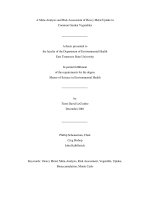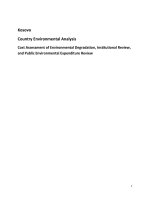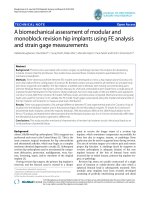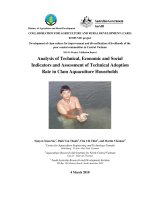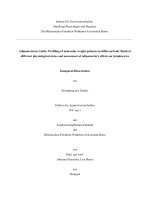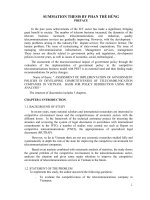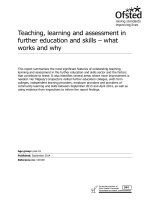ENG3061 Translation Analysis and Assessment U3 LiteraryTranslation Assessment 1
Bạn đang xem bản rút gọn của tài liệu. Xem và tải ngay bản đầy đủ của tài liệu tại đây (933.52 KB, 35 trang )
ENG3061 Translation Analysis and Assessment
U3 LiteraryTranslation Assessment [1]
Thu Ha Ngo
Division of Translation and Interpreting
House keeping
Skopos theory
For what?
For whom? Translation strategies
Things to nail today…
Translatable unit in Literary Translation
Literature and Literary translation
Prose
Poem – rhyme literature
What should be the best theoretical model
for literary translation?
Translatable unit in Prose
Word
Sentence
Beyond Sentence – text level
Writing style?
Four basic requirements
(Nida 1964:164)
Making sense;
Conveying the spirit and manner of the original;
Having a natural and easy form of expression
Producing a similar response
Meaning > style (Dolet 1540/1997,Tytler 1797)
Nida: regardless of poetry or prose: ―response of the
receptor‖ (131)
ultimate purpose of translation is ―a fundamental
factor in any evaluation of translations‖
―[T]he merit of the original work is so completely
transfused into another language as to be as distinctly
apprehended, and as strongly felt, by a native of the
country to which that language belongs, as it is by those
who speak the language of the original work‖ (Tyler
1797:14-15)
Case 3.1.1. LOLITA: DUONG TUONG &
THIEN LUONG
Lolita, light of my life, fire of my loins. My sin, my soul. Lolee-ta: the tip of the tongue taking a trip of three steps
down the palate to tap, at three, on the teeth. Lo. Lee.Ta.
She was Lo, plain Lo, in the morning, standing four feet ten
in one sock. She was Lola in slacks. She was Dolly at
school. She was Dolores on the dotted line. But in my arms
she was always Lolita.
(Lolita, Nabokov 1955)
―Lolita, ánh sáng đời tơi, lửa dục lịng tơi. Lầm lỗi của tôi,
linh hồn của tôi. Lo-li-ta: đầu lưỡi lướt ba bước xi vịm
miệng để vỗ nhẹ, tại bước ba, lên răng. Lo. Li. Ta.
Nàng là Lo, Lo đơn sơ, vào buổi sáng, đứng cao bốn foot
mười inch[1], đi một chiếc tất. Nàng là Lola mặc quần
dài. Nàng là Dolly ở trường học. Nàng là Dolores trên
dòng điền tên. Nhưng trong vịng tay tơi, nàng lúc nào
cũng là Lolita.‖
―Lolita, ánh sáng đời tơi, lửa dục lịng tơi. Lầm lỗi của tôi,
linh hồn của tôi. Lo-li-ta: đầu lưỡi lướt ba bước xi vịm
miệng để vỗ nhẹ, tại bước ba, lên răng. Lo. Li. Ta.
Nàng là Lo, Lo đơn sơ, vào buổi sáng, đứng cao bốn foot
mười inch[1], đi một chiếc tất. Nàng là Lola mặc quần
dài. Nàng là Dolly ở trường học. Nàng là Dolores trên
dòng điền tên. Nhưng trong vịng tay tơi, nàng lúc nào
cũng là Lolita.‖
[…] Ladies and gentlemen of the jury, exhibit
number one is what the seraphs, the
misinformed, simple, noble-winged seraphs,
envied. Look at this tangle of thorns.
(Lolita, Nabokov 1955)
[…] Thưa q bà và q ơng trong bồi thẩm
đồn, tang vật số một là cái mà những thiên
thần thượng đẳng có đơi cánh tuyệt trần,
những thiên thần hồn nhiên, khơng thấu
đáo sự tình, đã ghen tị. Xin hãy nhìn cuộn
gai rối ren này.‖ (Haze Dolores 2012)
[...]
The angels, not half so happy in Heaven,
Went envying her and me—
Yes!—that was the reason
(as all men know, In this kingdom by the sea)
That the wind came out of the cloud by night,
Chilling and killing my Annabel Lee.
[...]
(Trích Annabel Lee của Edgar Poe.)
Do misinformed (khơng được thơng tin chính xác, bị báo
tin sai lệch,...) về tình yêu của hai người, nên các thiên
thần ghen tị, và cướp nàng đi.
Tồn Phong („Trên dịng kẻ chấm‟ và chuyện dịch
thuật của Dương Tường 2012)
―Ai cũng biết ông Dương Tường nổi tiếng gàn
bướng. Ơng lại cịn tự tơn q thể đáng. Một loạt
dịch giả cuốn “L‟Étranger” của Albert Camus kể từ
trước 1975 đều dịch là “Kẻ xa lạ”, “Người xa lạ”...
Riêng ông, một mình một phách, ơng dịch: “Người
dưng”! Dẫu khơng đồng ý với lựa chọn của ơng, thì
cũng phải thấy đấy là một lối dịch độc đáo. Ơng
Tường ln muốn bản dịch của ơng chín nẫu tiếng
Việt!
Vậy mà cái vụ "on the dotted line" này, ông Tường
lại làm cái chuyện khác hẳn. Cái đoạn chữ này, ông
dịch bám trăm phần trăm.‖
Nabokov (1964:vii-viii)
―[T]o my ideal of literalism, I sacrificed everything –
elegance, euphony, clarity, good taste, modern usage, even
grammar‖
Nabokov 1965
“[S]tory of this translation is the story of a
disappointment. Alas, that 'wonderful Russian
language' which, I imagined, still awaits me
somewhere, which blooms like a faithful spring behind
the locked gate to which I, after so many years, still
possess the key, turned out to be non-existent, and there
is nothing beyond that gate, except for some burned out
stumps and hopeless autumnal emptiness, and the key in
my hand looks rather like a lock pick.―
Case 3.1.2. KAFKA
Franz Kafka (1883 – 1924): a Germanlanguage writer of novels and short
stories; ‗existentialism‘
Translation problems into English:
intentional use of ambiguous idioms and
words that have several meanings
extensive use of a characteristic particular
to the German language allowing for long
sentences that sometimes can span an
entire page an unexpected impact just
before the full stop—that being the
finalizing meaning and focus.
did not write in standard High German,
but rather in a Praguean German heavily
influenced by the Yiddish and Czech
languages
Kafkasque
In Vietnam:
1980s: Doan Tu Huyen & Duong Tat Tu
Vụ án - Hóa thân (Nxb Văn học, 1989, gồm hai truyện: "Vụ án",
Phùng Văn Tửu dịch từ tiếng Pháp, "Hóa thân", Đức Tài dịch
từ bản tiếng Anh);
Lâu đài (Trương Đăng Dung dịch từ tiếng Hung, Nxb Văn học,
1998).
2003, Tuyển tập tác phẩm Franz Kafkađược Nhà xuất bản Hội
nhà văn ấn hành, tập hợp những tác phẩm đã được dịch ra
tiếng Việt cho đến nay, bao gồm "Vụ án", "Lâu đài", "Hóa thân",
một số truyện ngắn, "Thư gửi Felice" và trích đoạn "Nhật ký
Kafka”.
2013, Thư gửi bố do Đinh Bá Anh dịch từ nguyên bản tiếng
Đức, được Nxb Hội nhà văn và Cơng ty Văn hóa Phương Nam
xuất bản.
From a third language translation (French, Russian, Rumanian…)
Lawrence Venuti
Born in 1953 in Philadelphia, US
A translator-theorist
―Traditionally, a fluent translation aimed to carry a text
effortlessly from one culture to another, completely
erasing distinctions.‖
What is ‘Invisibility’?
A term to describe the translator’s situation and
activity in contemporary Anglo-American culture
(Venuti 1995:1)
A product of the mindset of the translators and the
translation reception in the target culture
Fluency, Readability, Transparency (a translation is NOT a
translation but the ‗original‘)
Schleiermacher (1758-1834): ‗Uber die verschiedenen
Methoden des Ubersetzens‘ (1813)
Intentionally alienating the target language
Make the translation readers feel the SL
Herder (1744-1803):
language shapes the ideology / attitude
2 translation strategies:
Bringing the author to the readership
Bringing the readership to the author: accommodating approach
